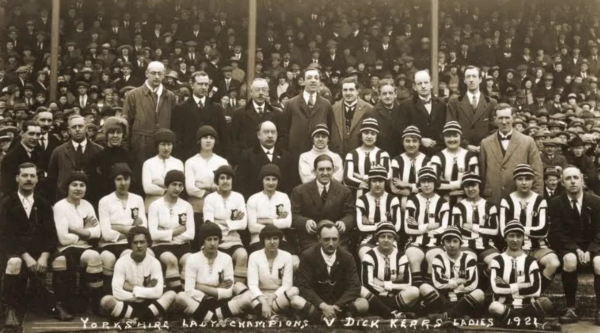The history behind the U.K.'s women's soccer ban

📚 The history
It reads like a Hollywood script. Over a century before England’s latest WWC and Euro successes, British women were blazing trails and setting soccer attendance records.
Women started kicking the ball around in the late 1800s, but the sport really exploded during World War I. With men’s competitive footy suspended from 1915 to 1919 due to the Great War, British women stepped up to fill the gap.
- Working in factories during the war, U.K. women competed in company-sponsored soccer clubs. They played charity matches that drew fans by the thousands. Munitions by day, bullets to the back of the net by night.
Even after the war ended and the men eventually returned to the pitch, the women’s game was still booming. On Boxing Day in 1920, over 53K fans (!!!) watched the famous Dick, Kerr Ladies beat St. Helen’s Ladies 4–0 in Liverpool, and an additional 10K to 15K were turned away at the gates.
- The match raised the equivalent of about $190K for charity and set an overall U.K. women’s soccer attendance record that stood until the 2012 London Olympics — 92 years later. The game also clocked in as the biggest women’s club match in history until nearly 100 years later. Incredible.
🚫 The ban

SOURCE: FOURFOURTWO.COM
And of course, that’s where things fell apart. Men returned to both factories and footy after the war, but the women’s company-sponsored matches were still drawing record crowds — often surpassing the audiences at men’s league games.
- The Football Association (FA) and governmental big-wigs couldn’t control the money raised by the women’s bouts — funds were no longer contributing to war efforts, but instead supporting working-class causes that threatened the establishment’s power.
- So a year later, on December 5th, 1921, the FA banned women’s footy from all FA–affiliated grounds, saying “the game of football is quite unsuitable for females and should not be encouraged.” Patriarchy at its finest.
While the FA couldn’t completely ban women from playing, it did halt the incredible momentum of women’s soccer by rendering crowds of any real measure impossible. Women’s teams could only play in parks, on public fields, or at sympathetic rugby or athletics clubs, all with nowhere near the capacity of FA pitches.
- We know “if you build it, they will come” rings true, but this proved the opposite — if you take away access, interest and fan fervor will dry up.
💪 Stubborn success

SOURCE: HISTORYOFSOCCER.INFO/LILY-PARR
Despite the ban, female players were undeterred. The women’s game persisted under the radar, and no team was more successful than the aforementioned Dick, Kerr Ladies from Preston, England, a squad sponsored by a local factory.
The star of that team? Lily Parr, a striker whose foot was so powerful, she reportedly broke the arm of a male professional goalkeeper and kept the remnants of a crossbar, damaged by another epic shot, in her trophy case. Legend.
- Parr notched over 900 goals in her 31-year career, including 43 during her first season…at only 14 (!!!) years old. It’s no wonder Scottish Football Hall of Famer Bobby Walker considered her a peer, calling Parr “the best natural timer of a football” he’d ever seen. Damn straight.
Twenty-four years after her death, Parr finally received her flowers. In 2002, she became the first woman ever inducted into the National Football Museum's Hall of Fame. As for the Dick, Kerr Ladies? They remain the most successful women’s team of all time. GOATs all around.
📈 Re-growing pains

The FA finally lifted the ban in 1971, but women’s footy in the U.K. struggled to rise to its previous heights. One stark example of the lack of support? During the 1995 Women’s World Cup, English players didn’t have a bus to take them to their quarter-final. Is hitchhiking still a thing?
- Players were considered amateurs and worked other full-time jobs, forcing them to squeeze in training sessions. It wasn’t until the 2000s that the country started putting pounds into the women’s game, instituting the first youth programs and offering small semi-pro contracts.
- The creation of the Women’s Super League in 2010 allowed more players to incrementally boost their pay and cut back on survival gigs. But it wasn’t until 2018, amidst a Barclays sponsorship and increasing interest in media rights, that the FA finally made it mandatory for women’s clubs to be both pro and full-time. About damn time.
🎉 Celebrating today and fighting for tomorrow

SOURCE: VUK VALCIC/SOPA IMAGES/LIGHTROCKET VIA GETTY IMAGES
England’s women are now attracting the crowds and recognition first captured by the sport’s pioneers. And despite the U.K.’s deep history of blocking women’s participation in the beautiful game, the last two years have been ones for the books.
- British women’s soccer is just over 50 years into its rebirth, but only five into full professionalization. Considering the country hadn’t won a major soccer tourney (women’s or men’s) in 56 years, last year’s Euro win (and this year’s WWC run!) hits that much deeper.
- And exactly like their (gr)ass-kicking predecessors, today’s squad is demanding more. They’ve been fighting for girls’ access to soccer across the U.K., calling out the government for better physical education and opportunities in schools.
Hear that? It’s the Dick, Kerr Ladies and the Lionesses roaring together.
Enjoying this article? Want more?

Sign up for The GIST and receive the latest sports news straight to your inbox three times a week.


